Have you ever opened your dishwasher to find water in the bottom while it wasn’t in use? If you see standing water in the bottom of your dishwasher, a repair may be required. While there are several reasons why your dishwasher’s water does not drain entirely, the majority of them do not necessitate a service call. Let’s solve this draining problem and get your dishes drying properly again.
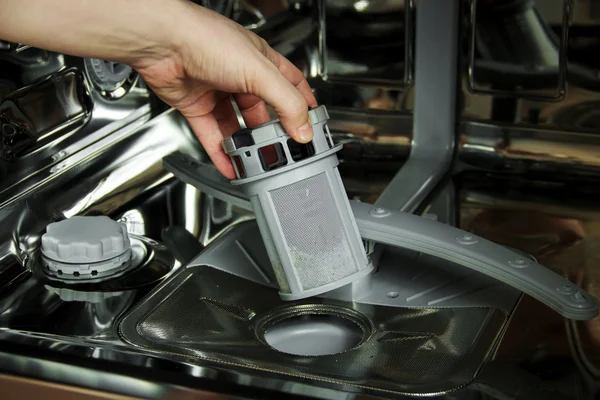
Should There Be Water in My Dishwasher?
It’s normal for your dishwasher to have no more than two cups of water left, after a run. Typically, the appliance remains wet after a cycle due to the condensation drying principle, which produces water droplets in the dishwasher – which are actually ideal here. If your filter is clogged, the appliance may be unable to pump away water as efficiently.
6 Signs Your Dishwasher Problems Are Caused By a Clog
1. You Hear Gurgling Sounds
If your dishwasher makes gurgling noises, it is trying to communicate with you. That gurgling is frequently a sign that the water isn’t draining properly, which could be due to a blockage somewhere in the system.
2. Your Dishwasher Is Backing Up Water in Your Sink
When you run your dishwasher and the water starts backing up into your kitchen sink, it’s a solid symptom of a clogged drain. Because the water has nowhere else to go, it attempts to escape through the first accessible outlet: your sink.
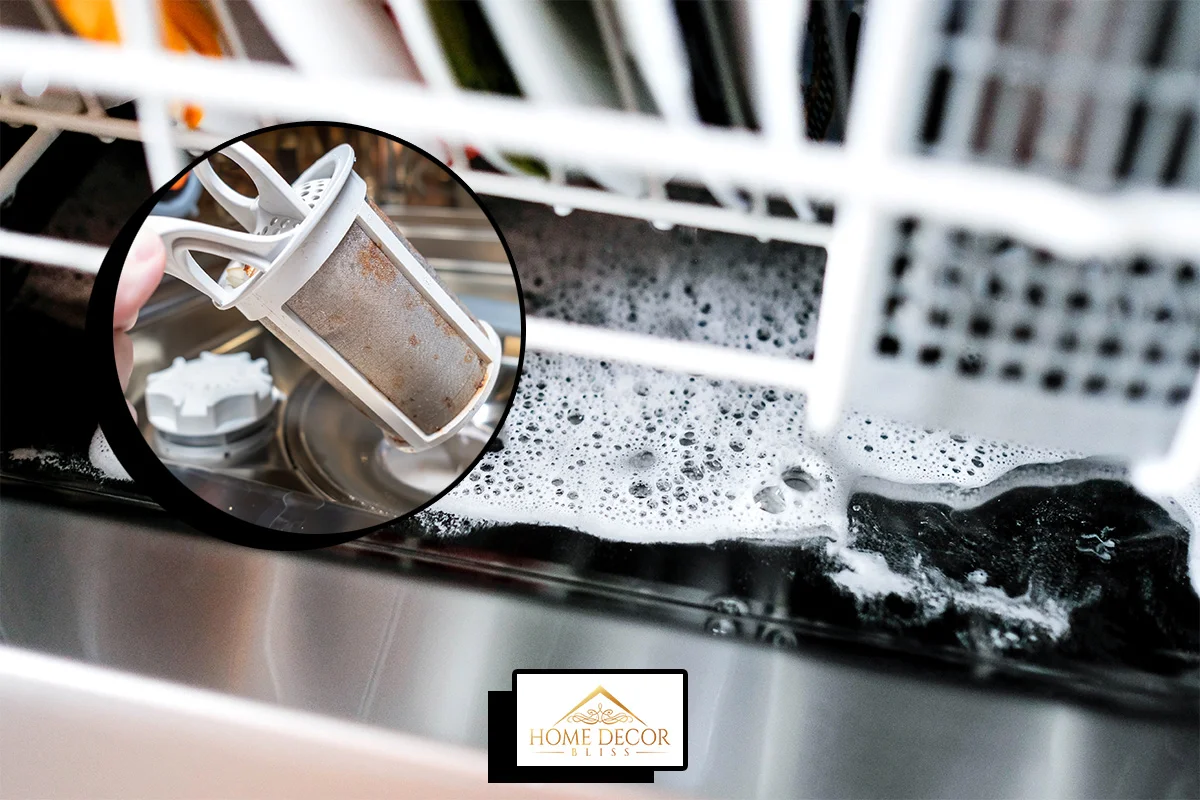
3. You Notice Slow Draining In Your Dishwasher
Pay attention to how long it takes for the water to drain from your dishwasher after a cycle. If it’s taking longer than normal or the water appears to be lingering there, there could be a clog causing the slowdown.
4. You See Water Backup In the Dishwasher After the Cycle
Standing water in your dishwasher after a wash cycle indicates that it is not draining properly. This is because leftover food has clogged the drainage system.
Inspect and clean your dishwasher’s drain basket. If this does not resolve the issue, your drains may be clogged.
5. Your Dishes Are Not Cleaned
If your dishes are still unclean after the wash cycle is completed, the dishwasher may not be filled with water. A clogged main or secondary sewer line is the cause of this.
6. Your Dishwasher Smells
A clogged filter basket is often the source of an unpleasant stench coming from your dishwasher. The filter screens away larger food particles, preventing them from clogging the drain. Without regular cleanings, these particles may accumulate and break down, generating odors and perhaps obstructing the drain.

How To Fix Water In the Bottom of A Dishwasher?
Okay, now that we’ve recognized the problem, let’s roll up our sleeves and get to work on resolving the water in the bottom of the dishwasher when not in use issue.
Turn Off the System’s Power
To avoid electric shock, disconnect the dishwasher or turn off the breaker in your electrical panel before servicing the appliance. Safety first, folks!
Remove the Water In Your Dishwasher
Line the floor under the dishwasher with towels and pour the water into a big basin or the sink using a pitcher or plastic container. When the water becomes too shallow to scoop, use a towel to soak up the remaining moisture.
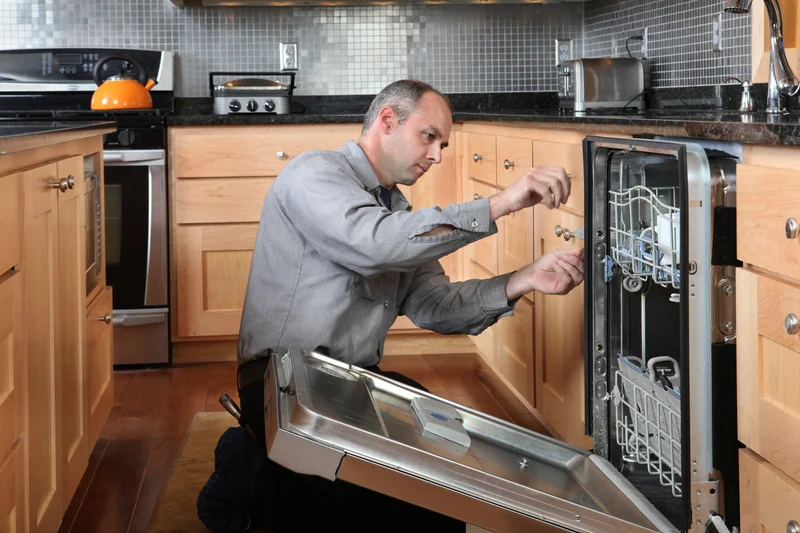
Check the Drainage System
Is your dishwasher not draining? One of the most common causes of water at the bottom of your dishwasher is obstructed drainage from food particles or other debris. Check the dishwasher drain and clean the drain basket around the lower sprayer arm with a wire hanger to remove any dirt. Make sure no large objects are covering or obstructing the sump region at the back of the tub. Check the drain pipe to ensure it is not kinked, twisted, or clogged. If it appears clear, proceed to the following step.
Clean the Pump
Clogs usually occur at the pump. The pump has two impellers: the higher one pumps water into the dishwasher, while the bottom one pumps it out the drain. Sometimes shattered glass and other debris hinder the impellers from rotating, allowing water to accumulate. Locate the pump (typically found at the bottom of the dishwasher) and remove any dirt or food particles that may be causing a blockage.
Clean the Sprayer Arms
While you’re at it, clean the sprayer arms. Gently remove the sprayer arms from the bottom of your dishwasher. Check the holes for food particles and remove it with a wire hanger. Rinse the arms with warm water, making sure to remove any food particles, and set aside.
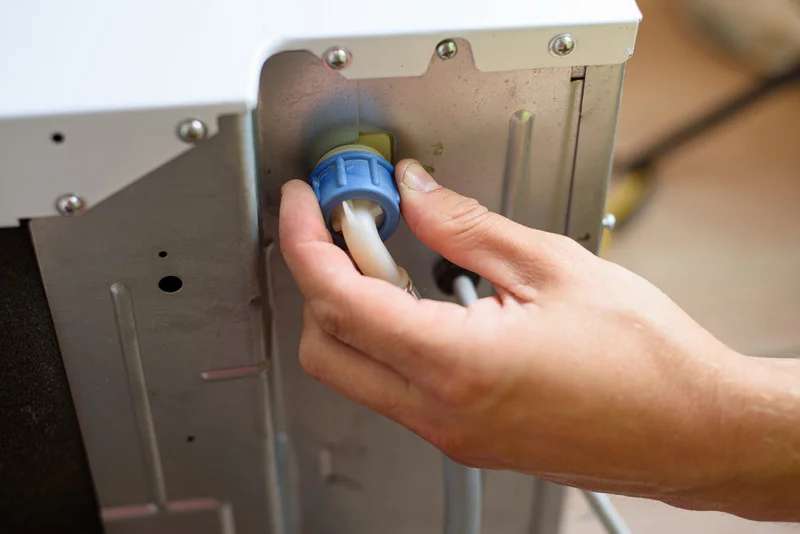
Clean the Dishwasher Filter
The majority of dishwashers contain a filter that collects trash and food particles. Most of the time, the dishwasher filter is near the back of the machine, on the bottom of the floor. Use a screwdriver to remove it. Rinse the screen with water and clean the surrounding area with a damp sponge. Replace both the screen and the sprayer arms.
Assess the Supply Line
If you have already cleared the screen and any drainage areas but the water is still pooling in your dishwasher, it’s likely due to a blockage in the supply line. Locate the supply line underneath your sink. Place a bucket beneath the line to catch any falling water, then disconnect the plumbing line that leads to the main drain. Allow the water to drain into the bucket, then check for obstructions and remove them. After eliminating any obstructions, reconnect the plumbing line and run an empty cycle through the dishwasher.
Clean the Drain Line
On occasion, the problem isn’t with the dishwasher per se, but with the pipe that delivers the water to the drain. You can find the dishwasher’s drain line under the filter screen, towards the rear of the appliance. Combine 1/2 cup baking soda and 1/2 cup water to make a paste. Pour the paste into the drain line via the filter screen. Pour 1/2 cup vinegar down the drain line and let it sit for 15 minutes. After 15 minutes, pour hot water down the drain to remove the baking soda solution.
Straighten Out the Drain Hose
In order for the water to flow properly, make sure that the drain hose is not kinked or bent in any way. Locate the dishwasher drain hose beneath the sink; it is often secured in place by clips or screws. Older drain hoses tend to kink, which can cause obstructions. If the drain hose has kinks, gently straighten them out.
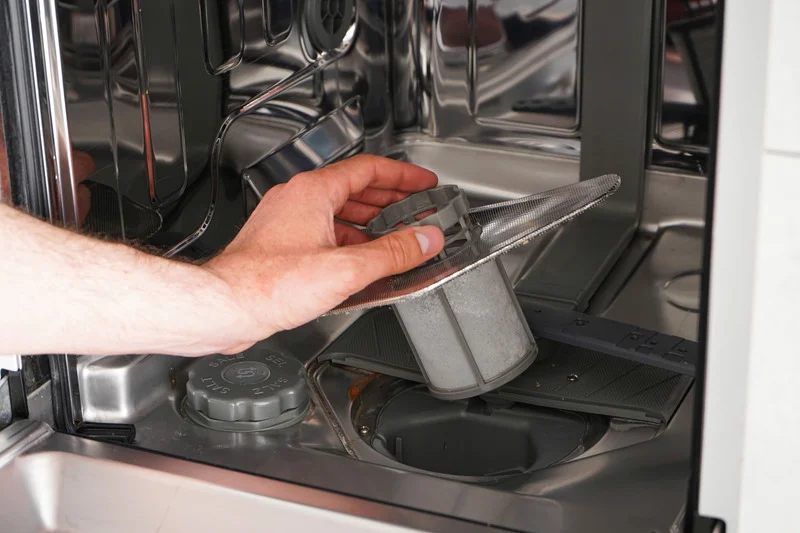
Run the Garbage Disposal
Since an air gap in a connected hose may prevent water from draining, disconnect the drain line from the garbage disposal and use a flat-head screwdriver to clean any clogs. After you’ve removed any obstructions, make sure the kitchen sink drain is clear and run the disposal. Never put your hands down the garbage disposal, as this might cause significant injury.
Run A Complete Cycle
After checking and cleaning everything, turn on the system and run a full dishwasher cycle to see if the water drains properly this time. If you notice an abnormal amount of standing water in the dishwasher, you should contact a professional.
How Can You Prevent Dishwasher Clogs?
Now that you’ve resolved the issue of water in the dishwasher’s bottom when it’s not in use, let’s talk about prevention. Here are some ways to keep your dishwasher running smoothly:
- Scrape off any large food particles from your dishes before loading them into the dishwasher.
- When using the dishwasher, choose the hot water cycle.
- Avoid putting non-dishwasher-safe items in the dishwasher, as they can break down and clog it.
- Clean your dishwasher’s filter on a regular basis to prevent buildup.
- Use a dishwasher cleaner or vinegar solution to remove any buildup or residue from the machine.
- Run the dishwasher frequently, always with dishwasher detergent.
- Check the drain hose and supply line for kinks or damage on a regular basis.
How To Tell When It’s Time to Replace a Dishwasher?
Sometimes, no matter how much you clean and troubleshoot, your dishwasher simply refuses to cooperate. If you’ve tried every solution and the water in the bottom of the dishwasher when not in use problem persists, it may be time to consider replacing your dishwasher entirely. Here are some indicators that it is time for a new one:
- All of the food particles remain on the plates.
- The glasses are clean but appear cloudy.
- The door doesn’t latch.
- The dishes never dry.
- There is standing water in the dishwasher after a cycle.
- Repairs are becoming increasingly frequent and costly.
- Your energy bills have been steadily rising due to an inefficient dishwasher.
- You are constantly dealing with leaks, clogs, and other major issues.
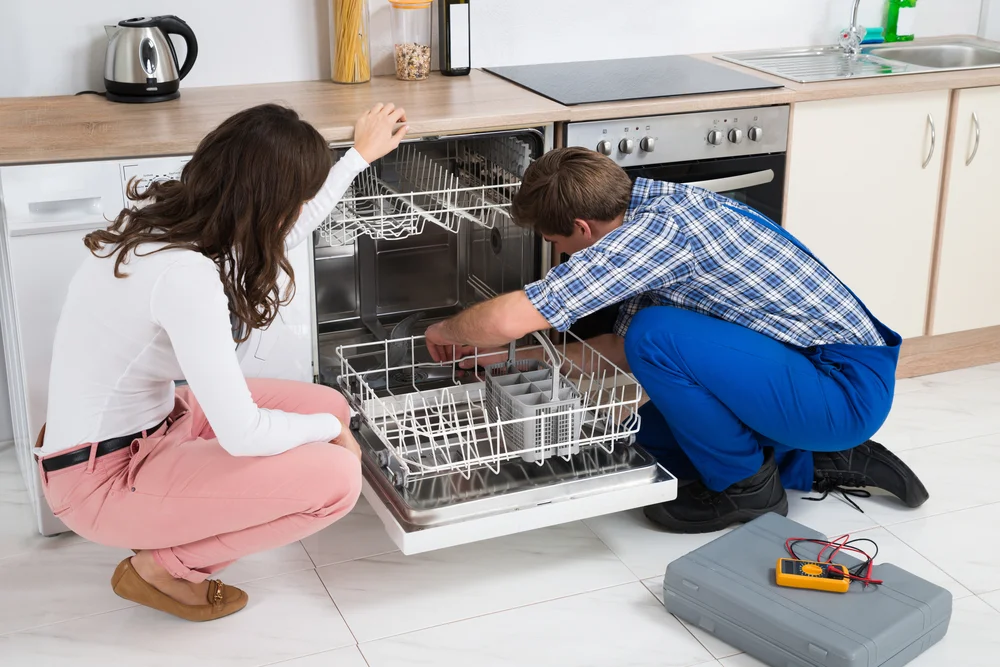
Conclusion
Water in the bottom of the dishwasher when it is not in use is a common problem with a simple solution – usually a clog somewhere in the process. Following the steps outlined above will allow you to identify the source of the problem and have your dishwasher running like new again. Remember, a little preventive maintenance goes a long way toward keeping clogs at bay. Happy dishwashing!
FAQs
Clogged Filters: The Silent Culprit
One of the most common reasons for water standing in the bottom of a dishwasher is a clogged filter. Just like any other appliance, dishwashers need regular maintenance to perform at their best.
Water Inlet Valve
If it becomes faulty, your dishwasher might fill up with too much water or fill up with water when it is turned off. To check the water inlet valve, you need to: Locate the water inlet valve. Check the valve for any signs of damage and if it can open and close correctly.
Use a DIY mixture of equal parts baking soda and vinegar to unclog the drain. Pour the solution into the basket at the bottom. Let it sit for 15 minutes. Finish by pouring hot water down the basket and running the rinse cycle.
You can manually remove excess standing water by removing the bottom rack and placing absorbent towels on the bottom of your dishwasher to soak up the remaining water. If your dishwasher has standing water due to an interrupted wash cycle, simply run another cycle without interruption.
A dishwasher has to physically pump the water out of it, and they really only hold enough water to fill the bottom. If it started to fill completely, the water would leak out all over the floor – the seals are not designed to hold back that kind of pressure.
Sources:
- Should there be standing water in this part of my dishwasher?
- How to unclog your dishwasher
- Should there be water at the bottom of my dishwasher?
- Why Is There Standing Water at the Bottom of My Dishwasher?
- How To Fix Water In The Bottom Of A Dishwasher
- Water in Bottom of Dishwasher? Quick Fixes!
- Why is there water in the bottom of my dishwasher when it’s not in use?
- How to Prevent Sink Water from Draining Into My Dishwasher?
- 5 Causes for Why Your Dishwasher is Leaking from the Bottom
- Dishwasher Filling With Water When Off
- Why Is My Dishwasher Leaking From the Bottom When It’s Not Running? How to Fix It
- Fix Standing Water in the Bottom of Your Dishwasher
- What to do if Your Dishwasher Leaks (And other Leaking Appliances)
- DISHWASHER NOT DRAINING? 3 REASONS WHY
- Water leaking from the bottom of the dishwasher at random…
- Should You Replace a Dishwasher Leaking From Bottom?
- 6 Signs Your Dishwasher is Clogged and How to Fix Dishwasher Problems
- Solved! What to Do When Your Dishwasher Is Not Draining
- Solved! Why Is There Water in the Bottom of My Dishwasher When It’s Not in Use?
- How to Fix Standing Water in Dishwasher
- Why is There Standing Water in my Dishwasher?
- Is There Standing Water In Your Dishwasher? Here’s How To Fix It
- Why Is There Water in My Dishwasher When Not in Use
- Water in Bottom of Dishwasher When Not in Use
- 7 Ways to Fix Standing Water in the Bottom of Your Dishwasher